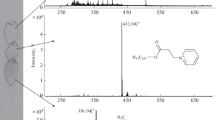Abstract
A plunger-based extraction device for HPTLC/MS coupling, which was originally designed for extraction on TLC aluminum foils, was enhanced. The threefold modifications enabled extraction of analytes from glass-backed HPTLC/TLC plates after separation. A buffering of the plunger reduced the occurrence of leakage. The involvement of a torque screwdriver for the fixation resulted in a reproducible contact pressure and avoided breaking the glass plates. The employment of this device was also extended to plates with a layer thickness of 100 μm by reducing the height of the plunger’s cutting edge. Repeatability of the extraction from glass-backed plates, linearity of the signal obtained, and detection capability were shown to be comparable to the original device, which was only usable with aluminum foils. The influence of the elution solvent on the intensity of the MS signal was demonstrated to be a compromise between high elution power of the solvent and good solubility of the analyte in the elution solvent. The extraction device was employed for plates from different lots and for plates with different stationary phases thereby proving its general applicability in planar chromatography.









Similar content being viewed by others
References
Fanibanda T, Milnes J, Gormally J (1994) Int J Mass Spectrom Ion Processes 140:127–130
Gusev AI (2000) Fresenius J Anal Chem 366:691–700
Crecelius A, Clench MR, Richards DS (2004) PharmaGenomics 4:36–38, 40, 42
Salo PK, Salomies H, Harju K, Ketola RA, Kotiaho T, Yli-Kauhaluoma J, Kostiainen R (2005) J Am Soc Mass Spectrom 16:906–915
Costello CE, Guittard JG, Hronowski XL, Costello CE (1999) Rapid Commun Mass Spectrom 13:1838–1849
Dreisewerd K, Kölbl S, Peter-Katalinic J, Berkenkamp J, Pohlentz G (2006) J Am Soc Mass Spectrom 17:139–150
Oriňák A, Vering G, Arlinghaus HF, Andersson JT, Halas L, Oriňáková R (2005) J Planar Chromatogr Modern TLC 18:44–50
Oka H, Ikai Y, Hayakawa J, Harada K, Masuda K, Suzuki M, Himei R, Horie M, Nakazawa H (1993) J Food Hygienic Soc Japan 34:517–523
Van Berkel GJ, Ford MJ, Deibel M.A. (2005) Anal Chem 77:1207–1215
Cody RB, Laramee JA, Durst HD (2005) Anal Chem 77:2202–2297
Morlock G, Schwack W (2006) Anal Bioanal Chem 385:586–595
Anderson RM, Busch KL (1998) J Planar Chromatogr Modern TLC 11:336–341
Kertesz V, Van Berkel GJ, Ford MJ (2005) Anal Chem 77:7183–7189
Prosek M, Milivojevic L, Krizman M (2004) J Planar Chromatogr Modern TLC 6:420–423
Luftmann H (2004) Anal Bioanal Chem 378:964–968
Morlock G, Nedele A, Schwack W (2005) Euro Food Chem XIII - Proceedings 2:513–516
Jautz U, Morlock G (2006) J Chromatogr A (in press)
Giachetti C, Assandri A, Zanolo G (1991) J Chromatogr 585:111–115
Herbert P, Santos L, Bastos M, Barros P, Alves A (2002) Food Chem Toxicol 67:1616–1620
Morlock G (2006) (in preparation)
Acknowledgements
The authors thank Professor Dr. Wolfgang Schwack, University of Hohenheim, for the excellent working conditions at the Institute of Food Chemistry. Special thanks go to Dr. Heinz-Emil Hauck, Merck, Darmstadt, Germany, for supply of plate material; to Dr. Luftmann, University of Münster, Germany, for providing the ChromeXtractor device; and to Dr. Konstantinos Natsias, CAMAG, Berlin, Germany, for support regarding equipment. Great thank goes to Landesstiftung Baden-Württemberg for financial support (project no. P-LS-E2/25).
Author information
Authors and Affiliations
Corresponding author
Rights and permissions
About this article
Cite this article
Alpmann, A., Morlock, G. Improved online coupling of planar chromatography with electrospray mass spectrometry: extraction of zones from glass plates. Anal Bioanal Chem 386, 1543–1551 (2006). https://doi.org/10.1007/s00216-006-0692-y
Received:
Revised:
Accepted:
Published:
Issue Date:
DOI: https://doi.org/10.1007/s00216-006-0692-y




